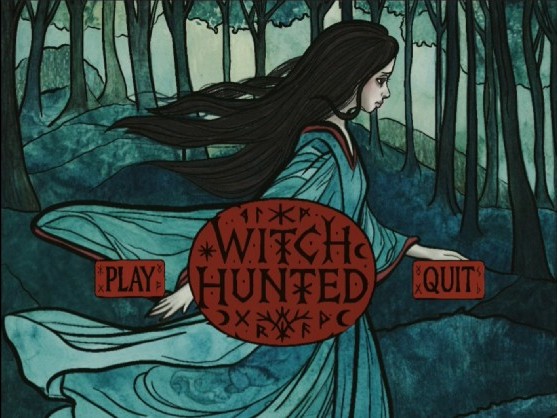Witch Hunted Devlog #3 - Procedural Generation & Player Needs
Hey again, thanks for reading! This week, I ended up working on the procedural forest a little more even though I said I wouldn’t, but I also made significant progress on player stats and a placeholder UI for them. Below is a detailed breakdown of the technical aspects of these implementations.
Refining Procedural Generation: Halls and Rooms
Why I Implemented Room-Based Generation
Previously, the forest relied on a random walker algorithm, which created an organic, cave-like layout. While this approach worked well for natural-looking environments, I wanted to experiment with a more structured procedural style, adding hallways and rooms to see how it would impact navigation and overall level design. This experiment also gave me a foundation to test different room styles and layouts for potential future enhancements.
How the System Works
To make structured layouts possible, I introduced an enum that allows switching between different procedural generation styles. Instead of the walker moving randomly in all directions, the new system constrains movement to a chosen direction for a set distance before changing paths. This change ensures that corridors feel intentional rather than purely random.
Rooms are generated at key points—either when a hallway stops or changes direction. The size of each room is randomized but follows constraints to maintain a balanced layout. The implementation uses a nested loop system to carve rooms into the grid, ensuring that every new hallway connects seamlessly with the explorable space.
Experimenting with Different Room Types
One of the main reasons I implemented this system was to experiment with different styles of room generation. While the current system creates rooms of varying sizes in a relatively uniform manner, I want to refine it further. In the future, I might develop a custom variation of the algorithm that prioritizes certain types of rooms based on environmental factors, allowing for more curated procedural generation.
Optimizations & Enhancements
To make the system more efficient and modular, I extracted frequently used logic into dedicated functions:
- Random room generation
- Hallway extension and connectivity checks
- Floor list validation to prevent overlapping rooms
Additionally, I implemented probability-based room placement, allowing rooms to spawn with varied densities instead of appearing at every turn. I also added an optional winding hallway mechanic, where some corridors continue uninterrupted instead of always leading to a room, adding variety to the generated maps. By adjusting these probabilities, I can fine-tune how structured or open-ended the forest feels.
Implementing Player Stats & UI
Player Needs System
After refining the procedural generation, I moved on to implementing a player needs system and a placeholder UI to track stats. Since the game features both a normal mode (which tracks health and magic) and a hard mode (which adds hunger and stamina), I structured the system to be flexible and modular.
I created a PlayerNeeds script that manages core attributes using a Need class, which includes:
- curValue – The current value of the stat.
- maxValue – The maximum possible value.
- startValue – The initial value when the game starts.
- regenRate – How quickly the stat regenerates over time.
- decayRate – How fast the stat depletes.
- UI Bar Reference – A connection to the corresponding visual element in the UI.
How Stats Behave in Game
Each stat updates dynamically based on player actions. For example:
- Health decays if hunger or stamina reach zero (hard mode only).
- Time.deltaTime is used to ensure gradual depletion instead of abrupt drops.
- Mathf.Min() and Mathf.Max() enforce logical limits on stat values.
Since survival mechanics play a role in the game, I designed the system to allow needs to interact—meaning that letting one stat drop too low can have cascading effects on others.
UI Implementation
To visualize player stats, I set up bar indicators that dynamically adjust based on the player's current values. These bars update in real-time using Unity’s UI Image fill amount property, ensuring smooth visual transitions when stats change.
Since my game is 2D, I avoided 3D-specific UI methods from the tutorial I referenced, ensuring that the UI integrates well with my existing canvas-based setup.
Next Steps
Now that the procedural generation and player stats systems are functional, my next focus will be inventory management and object interactions. This will involve:
- Item pickups/interactions – Allowing players to interact with, collect and store objects.
- Integrating the needs system – Items like food or potions will restore specific stats.
- Environmental interactions – Implementing interactable objects such as doors, chests, and other world elements.
That’s it for this update! Next time, I’ll share progress on inventory handling, item interactions, and further refinements.
Witch Hunted (Prototype)
A dark survival story of exile, ritual, and resilience.
| Status | In development |
| Author | BrigettethePigeon |
| Genre | Adventure |
More posts
- Devlog #9: Blood Deals and Broken CamerasApr 09, 2025
- Devlog #9 – Visual Tile Logic, Book Interface, Transition Effects and Patrol A...Apr 02, 2025
- Devlog #8: VFX, Cutscenes and MenusMar 26, 2025
- Devlog #7 - Refining Combat, Inventory Integration, and Adding Visual EffectsMar 20, 2025
- Devlog #6: Fixing Combat and Implementing Dynamic SystemsMar 12, 2025
- Devlog #5 - Combat, Crafting & Early Level ManagementMar 05, 2025
- Devlog 4: Inventory System & Item AssetsFeb 12, 2025
- Witch Hunted Devlog #2 - Exits, Doors, Items and EnemiesJan 29, 2025
- Witch Hunted Devlog 01Jan 22, 2025

Leave a comment
Log in with itch.io to leave a comment.